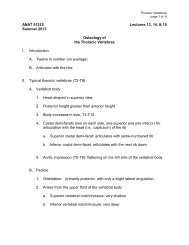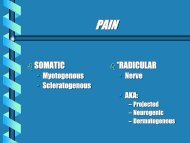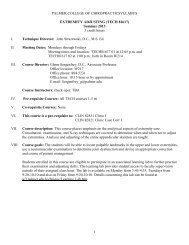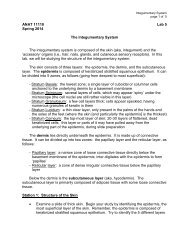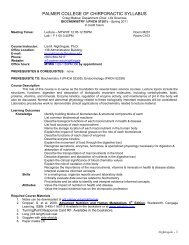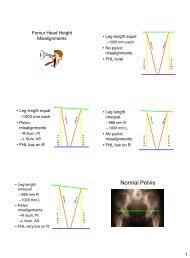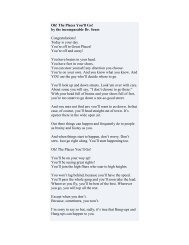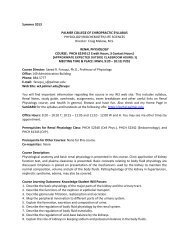Chemistry Review
Chemistry Review
Chemistry Review
Create successful ePaper yourself
Turn your PDF publications into a flip-book with our unique Google optimized e-Paper software.
MOLECULAR BONDING Based on valence electrons and electronegativity Valence electrons – e - in outermost shellCHEMISTRY REVIEWLia M. Nightingale, Ph.D.Ca +FFCaBonded pairUnshared pairFFCaFUnpaired e -ORFCaFMOLECULAR BONDING Electronegativity – how easily an element can acceptelectronsMOLECULAR BONDING In a molecule:• Higher electronegativity = e - acceptor• Lower electronegativity = e - donator• Electronegativity difference (ΔEN) = Highest # – lowest #FCaFCa = 1.0F = 4.0ΔEN = 3.0MOLECULAR BONDINGΔENBond Type0 – 0.4 Nonpolar CovalentElectrons shared equally0.41 – 1.7 Polar Covalentδ+ δ-Electrons shared inequally≥1.8 Ionic+ -Electrons transferredMOLECULAR BONDING Nonpolar covalent bonds• HydrophobicHHCHHH = 2.1C = 2.5ΔEN = 0.41
OH HINTERMOLECULAR FORCES3. Hydrogen bonding• Type of dipole-dipole interaction between H & F, O, or NINTERMOLECULAR FORCES3. Hydrogen bondingEN:C = 2.5H = 2.1O = 3.51. H must be bonded to FON (H-bond donor)AND2. FON must contain an unshared pair of electrons(H-bond acceptor)HHCHHCHδ-OHδ+H-bonds are only 2-5% as strong as ionic bonds.Pure ethanol solutionINTERMOLECULAR FORCES3. Hydrogen bonding Compounds can be JUST H-bond acceptors• H-bond acceptor = double bonded oxygen will accept a HINTERMOLECULAR FORCES H-bonding is responsible for:• Holding DNA strands togetherINTERMOLECULAR FORCESINTERMOLECULAR FORCES4. Ion-dipole interactions• Between ionic compound and polar molecules• + ion is attracted to δ -• - ion is attracted to δ +• Strongest IMF – still a lot weaker than covalent or ionicbonds4. Ion-dipole interactionsOH HOH HOH HNa + Cl -3
StrengthSTRENGTH OF INTRA & IMFEX. PURE METHANOL SOLUTIONHHCHOHEN:C = 2.5H = 2.1O = 3.5EX. PURE ETHANE SOLUTIONEX. PURE LITHIUM FLUORIDE SOLIDHHCHHCHHEN:C = 2.5H = 2.1LiFEN:Li = 1.0F = 4.0What IMF are present if LiF is dissolved in water?INTERMOLECULAR FORCES Affect:• Melting point (mp)• Boiling point (bp)• Viscosity*More IMF means themore energy (heat)needed to put into thesolution to break the IMF.Compound MW(g/mol) bp( C)CH 3 OH 32 65CH 3 CH 3 30 -89LiF 26 1681WHAT ARE THE IMF?HHHCHHCHHCHOOHCHHHEN:C = 2.5H = 2.1O = 3.5Pure ethanol MW = 46.07 g/mol bp = __________°CPure dimethyl ether MW = 46.07 g/mol bp = __________ C4
PRACTICE: WHAT ARE THE IMF?ORGANIC VS. INORGANICOCH HMW = 30.03 g/molHH C FHMW = 34.03 g/molHOOMW = 30.02 g/molHEN:C = 2.5H = 2.1O = 3.5F = 4.0HOH 3 C Organic = contains hydrocarbon (C & H)• Ex. Lipids, carbohydrates, proteins, vitamins, flavorcompoundsCH 3CH 3OCH 2CH2CH 2CH2CH 2CH2CH 2CH2CH 2CH2CH 2CH2CH 3CH 3CH3 CH 3α-tocopherol (Vitamin E)CH 3ORGANIC VS. INORGANICIDENTIFY EACH MOLECULE AS ORGANIC OR INORGANIC. Inorganic = does NOT contain hydrocarbon• Ex. Minerals, ionic salts, phosphate ionsHHHSO 4HCCCOHNaAl• Ca(PO 4 ) 2 – fertilizerHHHSO 4• CaHPO 4 – baking powder• CaCO 3 – calcium supplement in TUMs• CaC 2 O 4 – causes kidney stones (oxalate)CH 3OH CH 3H 3 C C C CH 3H 3 C CH 3CH 3C LENGTHThe more carbons a molecule has, themore nonpolar it becomes (lesspolar).ORGANIC REVIEW Primary (1 )• Group of interest bound to C that is only attached to 1 otherCHHCHHCHOH5
ORGANIC REVIEW Secondary (2 )• Group of interest attached to C that is bound to 2 other CORGANIC REVIEW Tertiary (3 )• Group of interest attached to C that is bound to 3 other CHHCHCH 3C OHHHHCHCH 3C OHCH 3ORGANIC REVIEWORGANIC REVIEW AlcoholRest of the moleculeHCHOH AldehydeOCH Ex. Ethanol Ex. 3-methylbutanalHHCHHCHOHCH 3 OCHCCH 3CH 2HORGANIC REVIEW MethanalH EthanalH 3 COCOCHHCH 3 CHOORGANIC REVIEW1. Are aldehydes polar?2. What types of IMF can form in aldehyde solutions? HexanalCH 3 CH 2 CH 2 CH 2 CH 2OCH6
ORGANIC REVIEW KetoneOCORGANIC REVIEW1. Are ketones polar?2. What types of IMF can form in ketone solutions? Ex.Propanone ORAcetoneOH 3 CCCH 3ORGANIC REVIEWORGANIC REVIEW Carboxylic acidO Pentanoic acidOCOHCH 3 (CH 2 ) 3COH Ex. Acetic acidButyric acidCH 3 (CH 2 ) 3 COOHH 3 COCOHCHCH 3CH 2OCOHORGANIC REVIEW When acids are ionized replace –ic acid with -ateORGANIC REVIEW What types of IMF will solutions of acids form?H 3 COCOHAcetic acidOCH 3 CAcetateO -H 3 COCOH7
ORGANIC REVIEWCH 3ORGANIC REVIEWCH CH 2CHC3 (CH 2 ) 3 CH 2 OCCH 2 CH 3CH 2 O CH3Pentyl propanoateCH 3 OO Ester = acid + alcoholOCOCH 3 (CH 2 ) 3 CH 2 OH + CH 3 CH 2 COOH Ex. Isoamyl acetate3-methyl butyl ethanoatePentanolPropanoic acidH 2 OApricotORGANIC REVIEWCan a pure ester solution H-bond?OORGANIC REVIEW Other esters• Wax = long chain alcohol esterified to long chain fatty acid(FA)Contains an ester bond!CH 3 (CH 2 ) 3 CH 2 OCCH 2 CH 3• Triglyceride = FAs esterified to glycerolOO H 2 C O CR’ C O CH OH 2 C O CRR’’ORGANIC REVIEW Ether = reaction of 2 alcoholsORGANIC REVIEWCan a pure ether solution H-bond? Ex. Diethyl etherOH 3 COH 2 C CH2 CH 3H 3 COH 2 C CH2 CH 38
PRACTICE: LIST IMF FOR EACH COMPOUND DISSOLVED INWATER.ORGANIC REVIEWCH 3 CH 2 CH 2 OCH 2 CH 3CH 3 (CH 2 ) 3 CH 2 OHCompound IMF in Pure SolutionsHydrocarbon LDFAlcoholLDF, dipole-dipole, H-bondAldehydeLDF, dipole-dipoleKetoneLDF, dipole-dipoleCarboxylic acid LDF, dipole-dipole, H-bondEsterLDF, dipole-dipoleEtherLDF, dipole-dipoleCH 3 (CH 2 ) 3 CH 3ORGANIC REVIEWCompound IMF in Polar SolutionsHydrocarbon LDFAlcohol LDF, dipole-dipole, H-bond (A, D)AldehydeLDF, dipole-dipole, H-bond (A)Ketone LDF, dipole-dipole, H-bond (A)Carboxylic acid LDF, dipole-dipole, H-bond (2A, D)EsterLDF, dipole-dipole, H-bond (2A)EtherLDF, dipole-dipole, H-bond (A)A = H-bond acceptor; D = H-bond donorORGANIC REVIEW Amine – derivative of ammonia, where 1 or more H isreplaced with alkyl or aryl group3Ammonia 1 Amine 2 AmineNH 3 NH 2NH CHCH 3CH 33 AmineCH 4 Ammonium ion3H 3 C N CH 3+H 3 C N CHCH 33CH 3ORGANIC REVIEW All amines are polar & water-soluble Primary & secondary amines can H-bondREACTION MECHANISMS1. Oxidation – lose electron• Also called dehydrogenationN-H - - HO-H - - HEN:N = 3.0H = 2.1O = 3.51. LEO says GERLEO = Lose Electrons OxidationGER = Gain Electrons Reduction2. OIL RIGOIL = Oxidation Is LosingRIG = Reduction Is Gaining9
REACTION MECHANISMSSIDE NOTE: BREATHALYZER REACTION1. Oxidation – lose electronOHR C HH[Ox][Red]ORCH[Ox][Red]ORCOH1 Alcohol Aldehyde Carboxylic AcidOHH 3 C CH 2[K 2 Cr 2 O 7 ]Cr 3+OH 3 CCH[K 2 Cr 2 O 7 ]Cr 3+OH 3 CCOHEthanol Ethanal Ethanoic acidMeasure concentration by spectrophotometryREACTION MECHANISMS1. Oxidation – lose electronREACTION MECHANISMS1. Oxidation – lose electronOHR C R’H[Ox][Red]ORCR’2 Alcohol KetoneOHR C R’R’’[Ox]3 Alcohol No ReactionREACTION MECHANISMSREACTION MECHANISMS1. Oxidation reactions found in:• Metabolism• Formation of heart disease LDL oxidation• Cancer Oxidation of DNA can initiate cancer• Aging Oxidation can damage tissues & cause wrinkles2. Reduction – gain electrons• Hydrogenation reactionsROCOH[H]ROCH[H]ROHC HHCarboxylic AcidAldehyde1 Alcohol10
REDUCTION EXAMPLEREACTION MECHANISMS2. ReductionO[H]CH 3 (CH 2 ) 4 COHHexanoic AcidHexanalOCH 3 (CH 2 ) 4 CH[H]CH 3 (CH 2 ) 4 CH 2 OHHexanolROCR’[H]ROHC RHKetone2° AlcoholREACTION MECHANISMS1 & 2. Reduction & Oxidation = RedoxREACTION MECHANISMS1& 2. Reduction & Oxidation = RedoxAH 2 + B A + BH 2Lose e - /H Gain e - /HOxidized ReducedOHOH 3 C CH 2 + NAD + H 3 C CH + NADH + H +Lose e - /H Gain e - /HOxidized ReducedREACTION MECHANISMS3. Dehydration/Condensation Removal of waterREACTION MECHANISMS4. Hydrolysis – reaction with waterOHCH 3 CH 2 CH 2H 2 SO 4heatCH 3 CH CH 2Water is a product!!+ H 2 OOOCH 3 [HCO CH3+ H 2 O + ]CH 3 OH + HOCCH 3OHCH 3 CH 2+OHCH 2 CH 3H 2 SO 4heatH 3 COH 2 C CH2 CH 3Water is a reactant!!+ H 2 O11
REACTION MECHANISMS5. Methylation – addition of CH 3OHH 3 C CH 2CH 3 IO CH 3H 3 C CH 2 +HIMETHYLATION Important for DNA modifications & enzymemodifications• Can turn molecules ON or OFF Makes molecule less polarREACTION MECHANISMS6. Phosphorylation – adding phosphate(PO 32-)REACTION MECHANISMS6. Phosphorylation – adding phosphate(PO 32-)AdeninePhosphatesP P PAdenine +ribose =AdenosineHP PCH 2 OHOH HPATPPPADPHCH 2 OHPOHRiboseAdenosine triphosphate (ATP)Adenosine diphosphate (ADP)HOOHHHOHOHGlucoseHOOHHHOHOHGlucose-6-phosphateSIDE NOTE: PHOSPHORYLATION p53 tumor suppressor gene• Normally phosphorylated at 18 sites; controls subscription ofproteins that restrain cell division• When damaged and not phosphorylated, allows cancer togrow out of control• p53 gene not working in 90% of skin cancer & 50% of allother cancersREVIEW Identify the following functional groups:OCH CH 2 CCH 3 CH 2 CH 2 OH12
REVIEW Identify the following functional groups :REVIEW Identify the following functional groups :CH CH 2CH 3 CH 2CH CH 3OCH 3CH CH 2CH 2 OC CH2CH 3NH 2REVIEW Identify the following functional groups :REVIEW Identify the following functional groups :OHHHHOHHCCCCCOOHHOHOHCH 2 OHREVIEW Identify the following functional groups :REVIEW Identify the following functional groups :OHOHHCH 2 OHC OC HC OHC OHCH 2 OH13
REVIEW Identify the type of IMF each molecule would form in apure solution:REVIEW Identify the type of IMF each molecule would form in apure solution:OHREVIEW Identify the type of IMF each molecule would form:REVIEW Identify the types of reactions:*If redox, identify molecule reduced and compound oxidized.K Cl + H 2 OHOHHCH 2 OHPC OC HCCOHOHCH 2 OPPPATPPPADPHOHHCH 2 OC OC HCCOHOHCH 2 OPPFructose-6-phosphateFructose-1,6-bisphosphateREVIEWREVIEW Identify the types of reactions:*If redox, identify molecule reduced and compound oxidized.CH 3CH 2CHCHCH 2CH 3+ H 2 OCH 3CH 2CH 2CH 2CH 2CH 3 Identify the types of reactions:*If redox, identify molecule reduced and compound oxidized.HHHOHHCCCCCOOHHOHOHCH 2 OHCH 3 IHHHOHHCCCCCOOHHOHOHCH 2 OCH 3+ HI14
REVIEWREVIEW Identify the types of reactions:*If redox, identify molecule reduced and compound oxidized. Identify the types of reactions:*If redox, identify molecule reduced and compound oxidized.HOHOHOCOHCOHOHHOO2Fe 3+ 2Fe 2+OOHHOHOOOO+ 2HHHOHHCCCCOHHOHOHHHOHHCCCCOHHOHOH+ H 2 OCH 2 OHCH 2 OHSUMMARY You should be able to:• Identify bonding types• Identify IMF• Determine whether a molecule is organic or inorganic• Draw basic organic structures• Recognize the main reaction mechanismsREFERENCES1. Brown. 1997. Introduction to Organic <strong>Chemistry</strong>.Saunders College Publishing.2. Nelson. 2000. Lehninger: Principles of Biochemistry,Third Edition. Worth Publishers.3. Boyer. 1999. Concepts in Biochemistry. Brooks/ColePublishing.15



